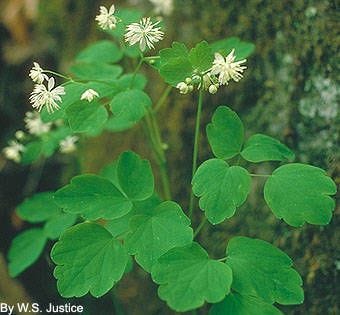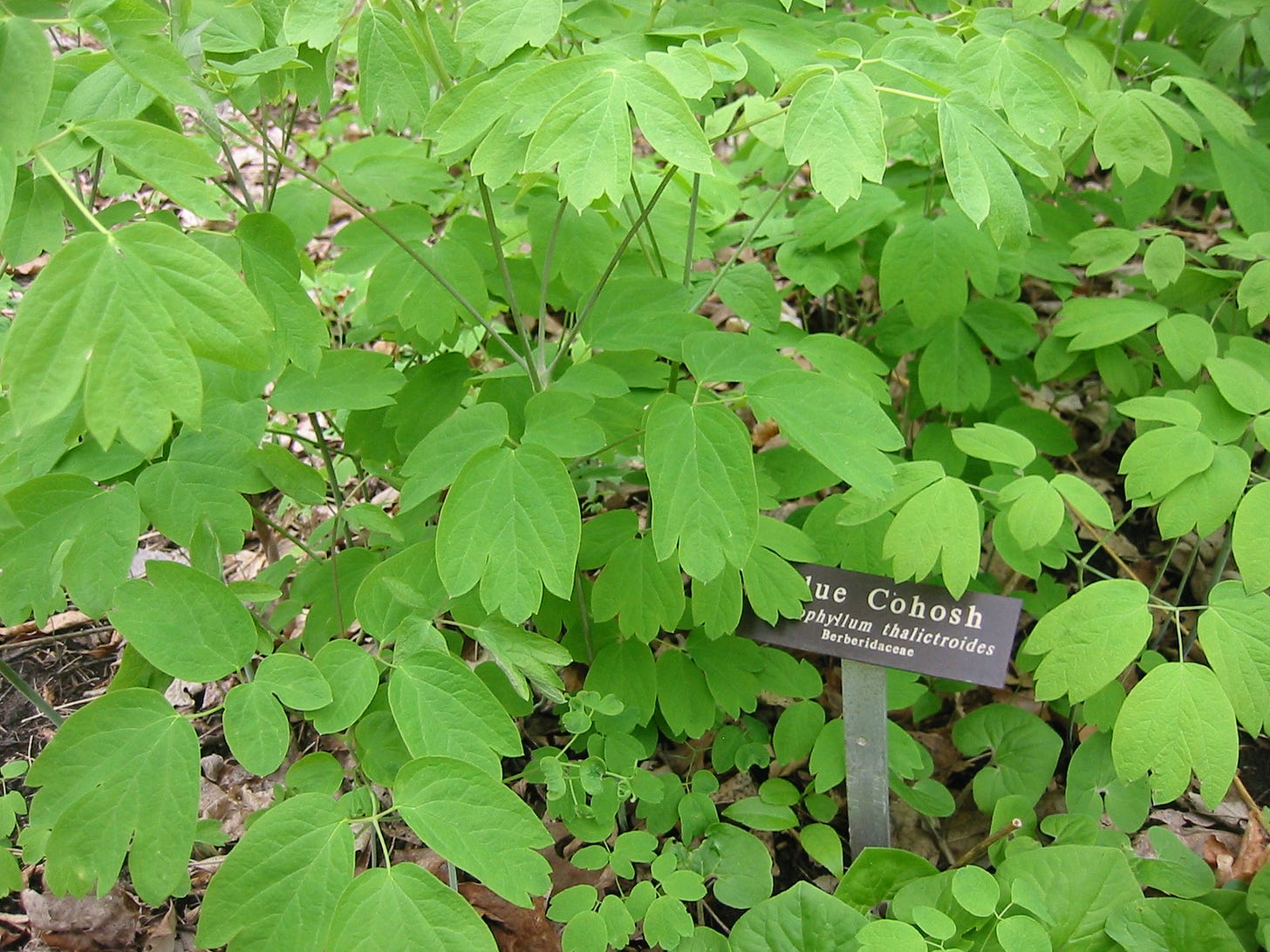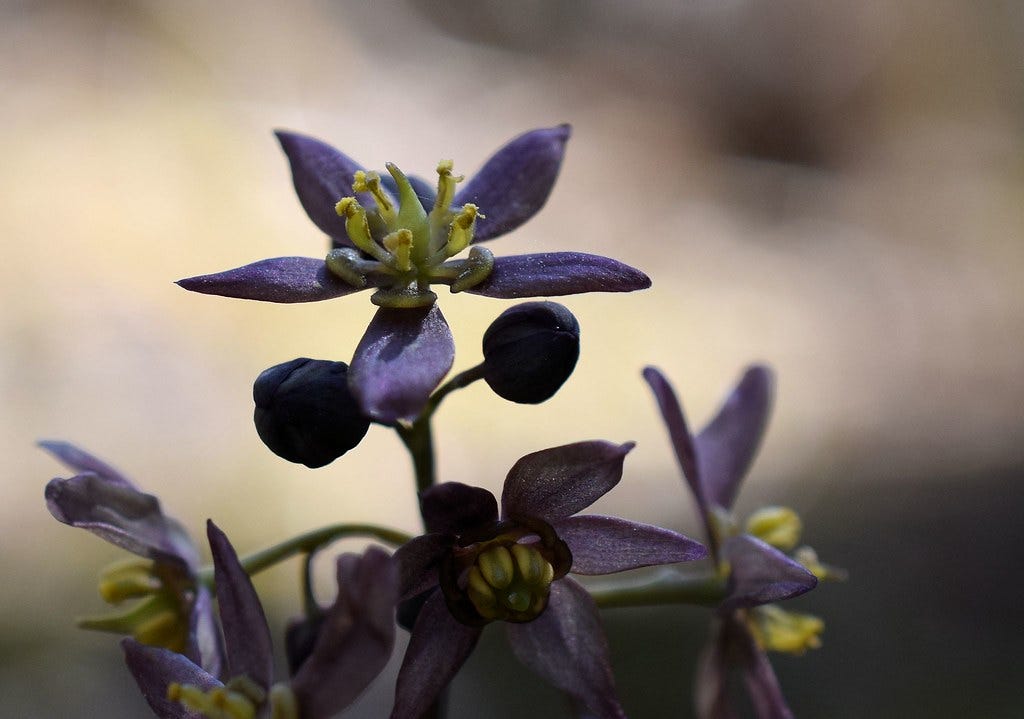ALSO KNOWN AS: Papoose-root, Caulophylle Faux-pigamon, Caulophyllum thalictroides
Not concord grapes that grow in vines. Though they also have small matte berries.
Or meadow rues that have a similar flower and leaf shape, but on a much smaller scale. Even the scientific name for blue cohosh, Caulophyllum thalictroides was borrowed from the meadow rue, Thalictrum rochebruneanum as if they came next in line.
How to know
Forest floor shrub 1-3’ tall
Leaves lobed into three like the footprint of some giant rabbit
A cluster of blue seeds at the crown
Five petaled flowers with bumps on them. Shaped like an open claw
If the world was covered in water, this blue-green home we call earth would look a lot like a blue cohosh seed, washed in an expanse of uncomplicated cobalt. But serenity is not so widespread, it’s hidden away beneath maples and basswood, lining the Allegheny mountains and tucked into the the Catskill valleys. Blue cohosh is a shrub that grows on the forest floor of the northeastern woodlands of the United States beside the Solomon’s seal or jack-in-the-pulpit, the myriad shade-loving plants that thrive in soft moist soils. They feed on lightly acidic loamy dirt, nourished by the rich layer of decaying matter on the forest floor. Rain drips from the leaves overhead covering the wood in a dank digesting smell the blue cohosh loves .
The young blue cohosh comes up purple and curled as a hawk’s talon in the first days of April.
As the shoots mature stems reach into a Y shape. All together the plant grows from between one to three feet in height with velvety leaves whose shape looks vaguely like a mammalian footprint. A central stem will then grow between the two, from which emerge clusters of chartreuse flowers which deepen to mauve. The flowers are bisexual and mature at different times to ensure cross pollination. Blue cohosh flower petals are fleshy and dark. They tempt pollinators with modified petals that have sweet ridges of nectar and welcome the first bees of spring: sweat bees, damsel bugs, and a cohort of flies. Upon pollination the ovule expands into its signature matte blue berries.
But the berries are not berries at all. Blue cohosh is unique in that it does not sweeten its seed with fruit, nor does it provide aerodynamic or aquatic features to disperse the seed. It doesn’t spend the energy on a hard shell to protect it. The seeds grow out in the open in attractive blue orbs. But these seeds need time, they soften throughout the summer, summoning deer mice, white tails, and birds to feast. If they are not eaten, they shrivel and fall where they are.
It can take years for a blue cohosh seed to germinate. They are slow plants in general. After they have established they grow slowly on underground rhizomatic organs that grow only inches beneath the dirt. In this way blue cohosh are found in colonies of green on the forest floor.
The Barberry family which contains blue cohosh, is in the order of Ranunculus, which includes buttercup and anemone. Though this family runs about 700 species deep in a variety of temperate regions all over the globe, the plants vary widely in appearance. Though many share ethnobotanical medicinal uses. While blue and black cohosh share a name they are not related at all. Blue cohosh are much more closely related to mayapple with their dramatically curved leaves and Oregon grape which shares a similar blue seed and compound leaf pattern. The term “cohosh”might be one of the only common English names of plants that has kept its Algonquin name, which likely translates to “rough”, relating to the gnarled rhizome that sits just below the topsoil. Both blue and black cohosh share similar traditional uses to treat ailments and conditions around birth and menstruation.
In the winter blue cohosh completely dies back. The mothlike wings disappear quickly and all that remains is the tight root underground. Their notable absence leaves clearings in woodlands.
In the winter months you may be able to identify where blue cohosh grows because nothing is there at all.
Blue cohosh seeds look a lot like Concord grapes, or blueberries, but the entire plant is poisonous. If any part is eaten it will cause severe stomach pains or cardiac collapse. Touching the root could cause itching and redness wherever it makes contact.
However, many know that blue cohosh has been a companion in the birthing process for thousands of years, specifically to the Potawatomi and the Cherokee who have used it to induce labor and abort pregnancies. It is a vulvic and ovarian tonic for menstruation because it reduces muscle spasms, so can soothe cramping. It is a sedative and acts as a warming agent in the body. Blue cohosh has been used to ease arthritis because it helps soothe joint pain as well.
It has been used to ease profuse menstrual bleeding by the Fox and Ojibway. Its roots are dried before they are made into a tea or tincture. But it has been known well by midwives. For a time between the late 1800’s until the mid 1900’s, blue cohosh was used in pharmaceutical remedies. In some countries it still is, but it can have adverse side effects that involve the complete upturning of the digestive system or the source of dangerous heart conditions. So many doctors warn against it. The root contains N-methylcytosine, which produce nicotine-like effects, meaning that it acts as a coronary constrictor, and thus used in postpartum blood loss. There seem to be moments when it is useful, and conditions for which it can be the ideal remedy. There are some medicines that are not for everyone. There are some medicines meant for a specific moment in our lives. Overall scientific studies have not proven the effectiveness of this drug, and many believe it is potentially too high a risk to take.
Studies on women’s health and for folks who have ovaries has been historically so underfunded and understudied there may be a usage or understanding of blue cohosh that traditional science holds that western science does not.
I have not worked with blue cohosh. I have not studied or administered it. But I wonder if the issue is less the study than the understanding of how to use it, with whom, and in what circumstance. This is not a recommendation but encouragement to continue the study of these plants, to acknowledge traditional ways of knowing and diversify the areas of study to include all people and all conditions. Blue cohosh points to what is missing in medicine.
The blue cohosh as a medicine, like its presence in the forest, makes itself visible, needed, and certain for one moment, one time of life, but then it disappears, leaving an opening big enough to see an absence.
Myth for blue cohosh
Look for the shadows, the places where an absence pulls.
Those places are thresholds between this world and another.
The blue cohosh was given the responsibility to hold the hand of those passing between worlds.
They create circles wherever they go: blue circles at their head in the summer, round openings in the forest in the winter.
They speak the language of the moon, punctuating the sacred cycles of life.
Forager Friendly?
Nope, I can’t recommend it. But if you’re interested in learning more about blue cohosh as a medicine consult with at least a couple of trusted doctors and experts.
Sources
https://www.youtube.com/watch?v=5KoJdDGsVMQ
https://www.prairienursery.com/blue-cohosh-caulophyllum-thalictroides.html
https://plants.ces.ncsu.edu/plants/caulophyllum-thalictroides/
https://www.sciencedirect.com/topics/medicine-and-dentistry/caulophyllum-thalictroides
https://mostlynativeshade.com/woodland-plants/
https://www.nature.com/immersive/d41586-023-01475-2/index.html
https://www.mofga.org/resources/herbs/blue-cohosh/









